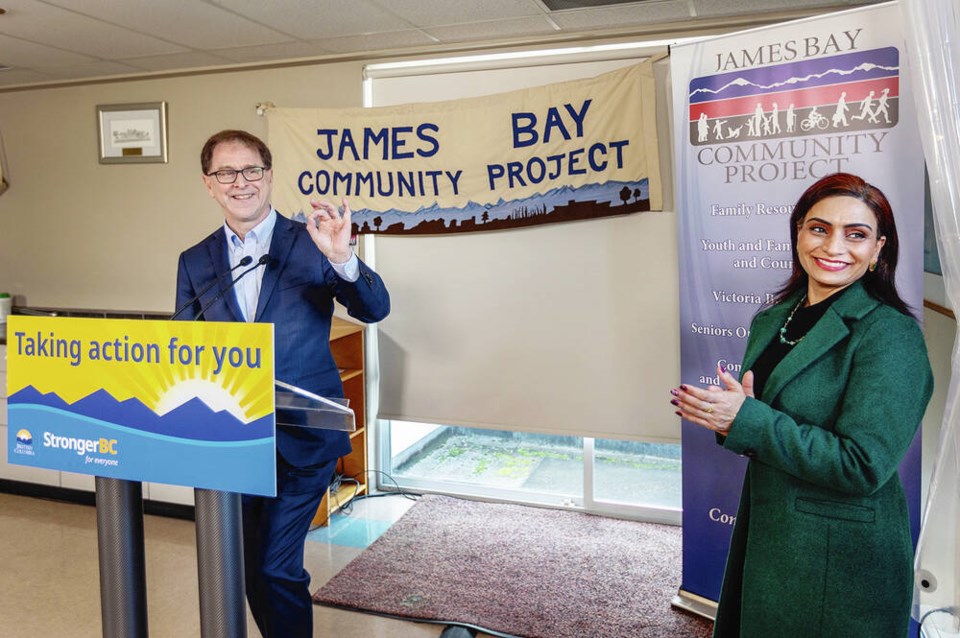Health Minister Adrian Dix laid out details in Victoria Wednesday for $354 million in funding over three years to expand programs to keep more seniors living at home.
The funding was part of the provincial budget unveiled last month.
In a news conference at the James Bay Community Project, Dix said community-based seniors’ services, delivered by non-profit agencies, and home health services, delivered by regional health authorities, will be enhanced to benefit seniors and take pressure off long-term care and assisted-living homes.
“With more seniors opting to live at home longer, we believe that means less demand than there would otherwise be for services such as long-term care, alleviating pressures in those aspects of the health-care system,” said Dix.
About 95 per cent of B.C.’s senior population aged 65 and older live independently, according to B.C.’s seniors advocate.
The $354 million in funding includes $227 million over three years to improve home health services for more seniors. Dix said the province will add 900 more health-care workers over three years — 400 full-time equivalent positions for community-based professional services and more than 500 FTEs for home-support workers.
“These will be nurses and social workers, physiotherapists and occupational therapists, and of course, health-care assistants and home support workers,” said Dix.
“People will see improved overnight response or regular contact with a care manager and improved response to care needs that arise unexpectedly.”
B.C. Seniors Advocate Isobel Mackenzie said the increased funding for services is both needed and welcome, but she has reservations as to how much it will help more seniors remain living independently in their homes.
“The degree to which this will address the major shortfalls in home support are unclear, as affordability is a major issue for the 70 per cent of B.C. seniors who are required to pay for their home support services — and this funding is directed to increasing the workforce,” Mackenzie said in an email on Wednesday.
Mackenzie said for those seniors who do receive home support, the average hours of care they receive has decreased four per cent over the past five years.
“Increasing the workforce will have a positive impact on reversing this trend,” she said.
In Mackenzie’s report on home support released last year, she noted that while the province has increased home support spending, a senior with an annual income of $29,000 in B.C. must pay $9,000 a year for a one-hour daily visit of home support, while a majority of other provinces do not charge for home support services.
As part of the announcement on Wednesday, Dix said $127 million will be invested to stabilize and expand high-demand non-medical services that operate province-wide for seniors, such as the 93 Better at Home programs in B.C.
Better at Home, a community-based program funded by the provincial government and managed by United Way B.C., provides seniors with access to non-medical home support services such as grocery shopping, light housekeeping, light yard work, snow shovelling, minor home repairs and transportation to appointments.
Dix said increased funding will put more emphasis on social connection “including social meals, peer support, expanded group activities and more flexible transportation options.”
Additionally, the Family and Friend Caregiver Support Program — which helps caregivers navigate the system — and Therapeutic Activation Program for Seniors — which offers frail seniors daily and weekly phone calls, transportation to programs as well as nutritious meals, exercise and educational programs — will each expand by about six to seven program sites per year, starting in 2025-26.
Another program, Social Prescribing, will see the number of so-called community connector positions in B.C. increase to 90 from 19 over two years. The community connectors provide one-on-one support to seniors who are frail or at risk of frailty, to develop health and wellness plans and to connect them to community programs, Dix said.
“In other words, allowing people to live better and also avoid going, for example, to long-term care,” he said. “All of these investments mean more seniors will be empowered to age with dignity in the comfort of their own homes.”
The senior population aged 65 and older has grown to 19.6 per cent in 2023-2024 from 17.7 per cent in 2017-18, said Dix, who added that population is forecast to grow to almost 22 per cent over the next decade, placing “unprecedented” demand on the health-care system.



